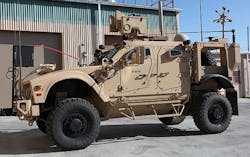General Dynamics wins major WIN-T battlefield networking contract to link Army warfighters
FAIRFAX, Va., 17 July 2015. The General Dynamics Corp. Mission Systems segment in Fairfax, Va., will build more than 300 vehicle-based network communication nodes for the U.S. Army's Warfighter Information Network –Tactical (WIN-T) under terms of a $219 million order.
The first Army full-rate production order for WIN-T Increment 2 battlefield networking systems includes related equipment and materials, and enables the Army to continue fielding WIN-T Increment 2 to Army units scheduled to receive the system.
WIN-T Increment 2 is the Army's communications backbone providing secure, on-the-move communications, mission command and situational awareness for commanders and warfighters.
WIN-T Increment 2 is integrated into Mine-resistant Ambush Protected (MRAP), High Mobility Multipurpose Wheeled Vehicles (HMMWV), and Stryker vehicles. To date, four division headquarters and 12 brigade combat teams have WIN-T Increment 2.
Related: GDC4 Systems to prepare WIN-T Increment 3 for deployment in $475 million contract
The system served Army units supporting the security force assistance brigades in Afghanistan by replacing the fixed communications infrastructure that was dismantled when the U.S. military closed its operating bases, company officials say.
Last summer, WIN-T provided the 'communications grid' for humanitarian operations responding to the Ebola epidemic in West Africa.
"WIN-T Increment 2 puts the power of the soldier's network into soldiers hands down to the company level," says Chris Marzilli, president of General Dynamics Mission Systems. General Dynamics builds the WIN-T system primarily in Taunton, Mass.
General Dynamics Mission Systems is a combination of the company's former Advanced Information Systems and C4 Systems. For more information contact General Dynamics Mission Systems online at www.gd-ais.com.

